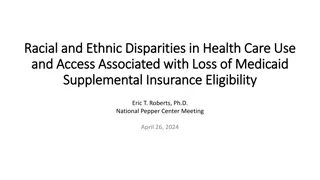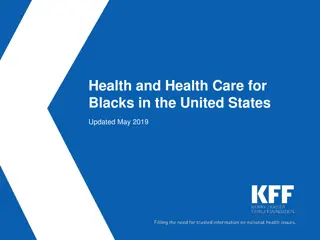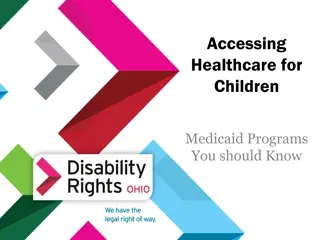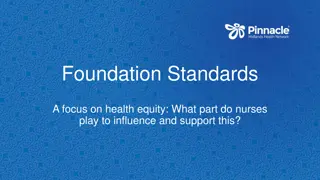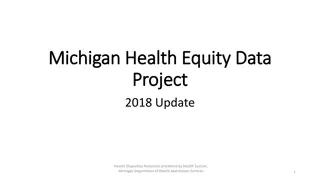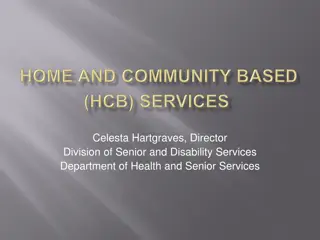Understanding Health Disparities and Medicaid's Role in Advancing Equity
Health and health care disparities refer to differences in health outcomes and access to care among different groups, often linked to social, economic, and environmental inequities. People of color face longstanding disparities in health and health care, with factors inside and outside the health care system driving these disparities. This highlights the importance of achieving health equity for all individuals, as outlined in Healthy People 2030. Medicaid plays a crucial role in addressing these disparities and advancing health equity.
Download Presentation

Please find below an Image/Link to download the presentation.
The content on the website is provided AS IS for your information and personal use only. It may not be sold, licensed, or shared on other websites without obtaining consent from the author. Download presentation by click this link. If you encounter any issues during the download, it is possible that the publisher has removed the file from their server.
E N D
Presentation Transcript
Health and Health Care Disparities and the Role of Medicaid in Advancing Equity Samantha Artiga Vice President and Director, Racial Equity and Health Policy
Figure 1 What are health and health care disparities? Disparities refer to differences in health and health care between groups Higher burden of illness, injury, disability, or mortality Differences in insurance coverage, access to and use of care, and quality of care Closely linked with social, economic, and environmental inequities Adversely affect groups who have systematically experienced greater obstacles to health Racism results in conditions that unfairly advantage some and disadvantage others, placing people of color at greater risk for poor health outcomes Health equity refers to attainment of the highest level of health for all people (Healthy People 2030)
Figure 2 People of color face longstanding disparities in health and health care. Number of measures of health and health care for which group fared better, the same, or worse compared to White counterparts: 2 9 9 15 7 26 12 7 37 Data Limitation Better No Difference Worse 6 15 45 39 9 34 20 13 Black Hispanic AIAN NHOPI Asian Note: AIAN is American Indian or Alaska Native; NHOPI is Native Hawaiian or Other Pacific Islander. Measures are for the most recent year for which data are available. "Better" or "Worse" indicates a statistically significant difference from White people at the p<0.05 level. No difference indicates no statistically significant difference. "Data limitation" indicates no separate data for a racial/ethnic group, insufficient data for a reliable estimate, or comparisons not possible due to overlapping samples. Persons of Hispanic origin may be of any race but are categorized as Hispanic for this analysis; other groups are non-Hispanic. Source: Key Facts on Health and Health Care by Race and Ethnicity, KFF January 2022
Figure 3 Health disparities are driven by factors inside and beyond the health care system. Neighborhood and Physical Environment Community, Safety, & Social Context Economic Stability Education Food Health Care System Racism and Discrimination Literacy Employment Housing Food security Social integration Health coverage Income Transportation Language Access to healthy options Support systems Provider & pharmacy availability Expenses Parks Early childhood education Community engagement Access to linguistically and culturally appropriate & respectful care Debt Playgrounds Vocational training Stress Medical bills Walkability Exposure to violence/trauma Support Zip code/ geography Higher education Quality of care Policing/justice policy Health and Well-Being: Mortality, Morbidity, Life Expectancy, Health Care Expenditures, Health Status, Functional Limitations
Figure 4 Addressing disparities is important for social justice and the nation s overall health and economic prosperity. Disparities result in unnecessary health care costs and limit the overall health and productivity of the nation As the population becomes more diverse it is increasingly important to address disparities Addressing the disparate impacts of COVID-19 is important for preventing against further widening of health disparities Now is a pivotal time for translating attention to disparities into action to advance equity Medicaid can serve as a key driver of health equity, but disparities remain for people in Medicaid and CHIP
Figure 5 The ACA coverage expansions helped narrow gaps in health coverage for people of color, but disparities persist. Uninsured Rates for the Nonelderly Population by Race and Ethnicity, 2010-2019 32.6% 30.5% 32.0% 30.2% 25.6% AIAN 22.0% 21.8% 24.8% 21.7% Hispanic 19.9% 18.9% 20.0% 17.9% 18.5% 19.1% 19.0% 14.9% NHOPI 16.7% 16.3% 12.7% 11.5% Black 13.9% 10.7% 11.2% 11.4% 13.1% 12.5% 9.3% White Asian 10.8% 7.5% 7.8% 7.2% 9.8% 6.8% 2018 7.1% 2016 2010 2011 2012 2013 2014 2015 2017 2019 NOTE: Includes individuals ages 0 to 64. AIAN refers to American Indians and Alaska Natives, NHOPI refers to Native Hawaiians and Other Pacific Islanders. Persons of Hispanic origin may be of any race but are categorized as Hispanic for this analysis; other groups are non-Hispanic SOURCE: KFF analysis of the 2010-2019 American Community Survey.
Figure 6 Medicaid plays a disproportionately large role for people of color. Health Coverage of the Nonelderly Population by Race and Ethnicity, 2020 6% 7% 12% 12% 20% 22% 18% 19% Uninsured Medicaid/Other Public Private 36% 35% 33% 35% 76% 74% 53% 52% 48% 43% American Indian or Alaska Native Black Hispanic Native Hawaiian or Other Pacific Islander White Asian NOTE: Includes individuals ages 0 to 64. Persons of Hispanic origin may be of any race but are categorized as Hispanic for this analysis; other groups are non-Hispanic. Other public coverage includes Medicare (excluding Part A only) and military coverage. Totals may not sum to 100 percent due to rounding. SOURCE: KFF estimates based on the Census Bureau's March Current Population Survey (CPS: Annual Social and Economic Supplements), 2021.
Figure 7 Medicaid plays an even larger role for children of color. Health Coverage of Children by Race and Ethnicity, 2020 3% 4% 6% 9% 17% 25% 27% Uninsured Medicaid/Other Public Private 54% 47% 52% 52% 73% 69% 43% 40% 38% 31% Black Hispanic American Indian or Alaska Native Native Hawaiian or Other Pacific Islander* White Asian NOTE: *Uninsured rate for Native Hawaiian and Other Pacific Islander children is not reported because it has a relative standard error above 30%. Includes children ages 0 to 18. Persons of Hispanic origin may be of any race but are categorized as Hispanic for this analysis; other groups are non- Hispanic. Other public coverage includes Medicare (excluding Part A only) and military coverage. Totals may not sum to 100 percent due to rounding. SOURCE: KFF estimates based on the Census Bureau's March Current Population Survey (CPS: Annual Social and Economic Supplements), 2021.
Figure 8 Studies generally find positive effects of the ACA Medicaid expansion across a range of outcomes. Number of studies that find positive effects, no difference or mixed findings, and negative effects: # of studies that find positive effects # of studies that find no difference or mixed findings # of studies that find negative effects Access & Utilization of Care 184 79 Insurance Coverage 201 13 2 Payer Mix 99 Health Care Affordability & Financial Security 66 14 Provider Capacity 18 21 3 Self-Reported Health 20 19 State Economy 25 Positive Health Outcomes 21 22 3 NOTES: Studies may have findings on multiple outcomes and be counted in multiple bars. Insurance Coverage includes coverage rates generally and for Medicaid. SOURCE: KFF analysis of 601studies of the impact of state Medicaid expansion published between January 2014 and March 2021.
Figure 9 The Medicaid coverage gap disproportionately affects people of color. Share of the Nonelderly Population that is Black by Medicaid Expansion Status Race/Ethnicity of Adults in the Coverage Gap Other 4% Hispanic 29% White 41% Black 25% 2.2 Million Adults NOTE: Totals may not sum to 100% due to rounding. Nonelderly includes individuals ages 0 to 64. Other includes Asian, American Indian Alaska Native, and Native Hawaiian and Other Pacific Islander people, along with people of multiple races. Hispanic people may be of any race but are categorized as Hispanic; other groups are all non-Hispanic. SOURCES: KFF analysis of 2019 American Community Survey, 1-Year Estimates and KFF Status of State Medicaid Expansion Decision as of January 2022.
Figure 10 Health equity is a key priority identified by President Biden, CMS, and state Medicaid agencies. Key Focus Areas in CMS Strategic Vision: Coverage & Access Equity Innovation & Whole-Person Care SOURCE: Chiquita Brooks-LaSure and Daniel Tsai, A Strategic Vision for Medicaid And The Children s Health Insurance Program (CHIP), Health Affairs (November 2021): https://www.healthaffairs.org/do/10.1377/forefront.20211115.537685/full/
Figure 11 Recent federal policies could help address health disparities. American Rescue Plan Act option to extend Medicaid postpartum coverage from 60 days to 12 months American Rescue Plan Act fiscal incentive to adopt Medicaid expansion Reversal of Trump Administration changes to public charge policies Increased funding for Navigators and enrollment assistance Enhanced racial/ethnic data collection and reporting Proposed rule to improve retention of Medicaid coverage and remove barriers to CHIP coverage
Figure 12 75% of states reported Medicaid initiatives to address racial/ethnic health disparities in FY 2021 or FY 2022. NOTES: n = 47 responding states. *States reported targeting disparities in other specific health outcomes including diabetes, oral health, HIV, colorectal exams, sickle cell anemia, outcomes for people with complex health needs, and specific disease states associated with disparities. SOURCE: KFF survey of Medicaid officials in 50 states and DC conducted by HMA, October 2021.
Figure 13 At least 36 states have taken steps to extend Medicaid postpartum coverage. Approved & pending state actions as of 9/9/22, including: 12-month extension implemented (26 states including DC) Planning to implement a 12-month extension (8 states) Limited coverage extension proposed (2 states)* NOTE: *These extensions would limit the postpartum coverage time period and/or eligible populations as compared to the 12-month postpartum extension option in the federal American Rescue Plan Act. SOURCE: Medicaid Postpartum Coverage Extension Tracker, https://www.kff.org/medicaid/issue-brief/medicaid-postpartum-coverage-extension-tracker/
Figure 14 Across provisions in Section 1115 waiver requests, many states identify health equity as a key goal. Themes in Pending Waivers Include: Eligibility Expansions Expanded postpartum coverage Provide services to incarcerated individuals pre- release Social Determinants of Health Housing & housing- related supports Provide or connect individuals to other non-medical resources Behavioral Health Expanded eligibility for individuals w/ SUD or SMI Community-based behavioral health benefit expansions Health Equity Equity-related incentive payments for providers Financial support to improve collection of race/ethnicity data
Figure 15 Looking ahead Racial disparities in health and health care remain a persistent issue and will likely widen due to COVID-19 Medicaid can play an important role in addressing disparities as a major source of coverage for people of color and driver of innovation Many initiatives currently underway in Medicaid are focused on advancing health equity Continued expansions in Medicaid could further narrow disparities in coverage, which is tied to improvements in access to and use of care Maintaining coverage of eligible people at the end of the public health emergency will be important for preventing growing gaps in coverage Beyond coverage, addressing social and economic inequities will be key for improvements in health and health equity





